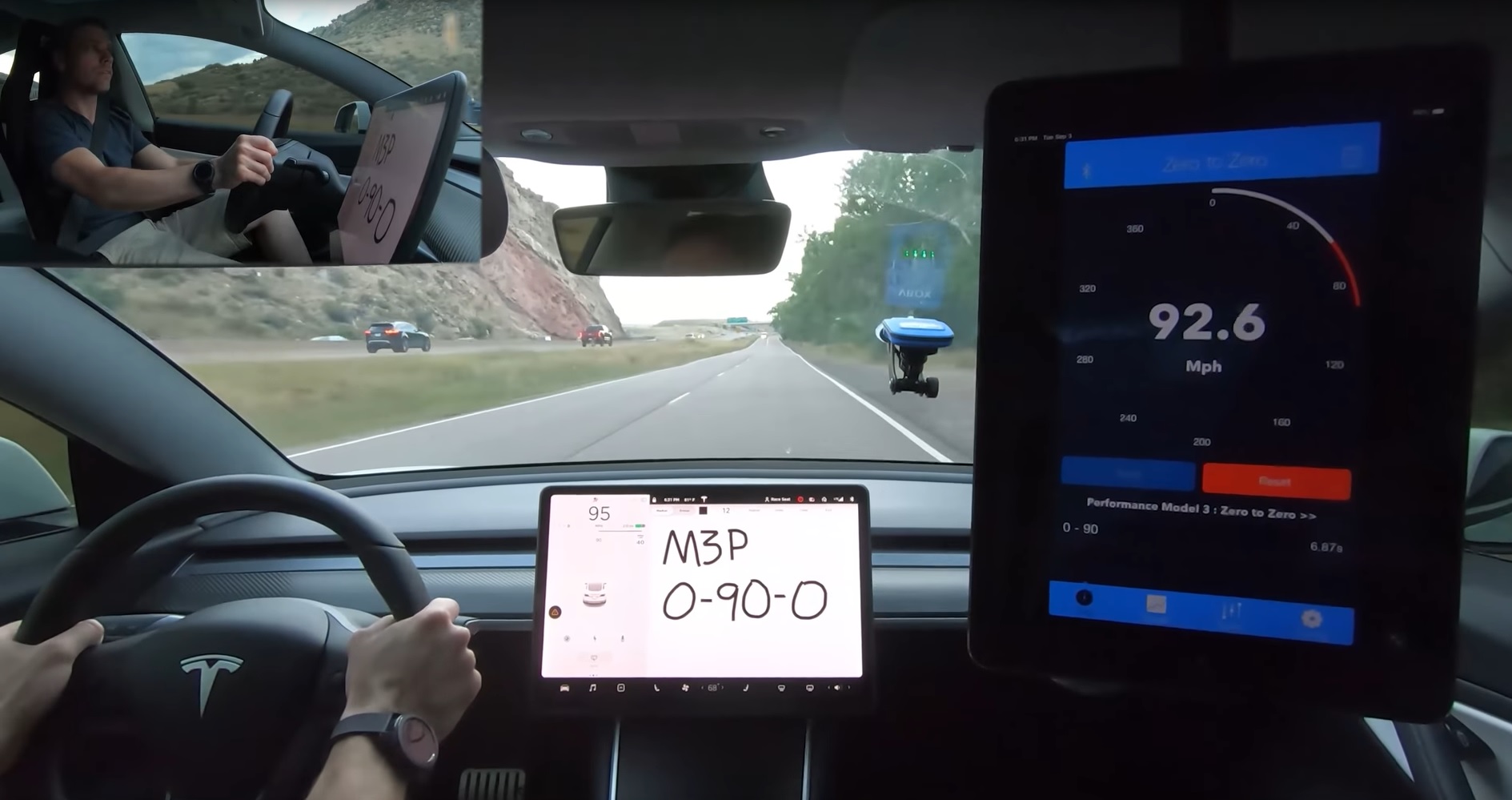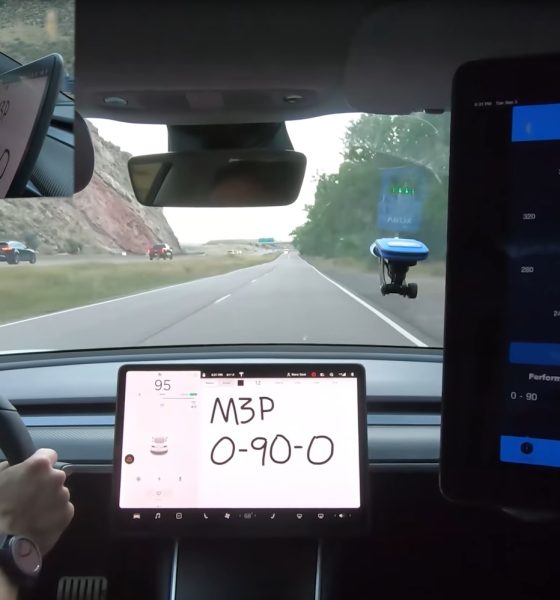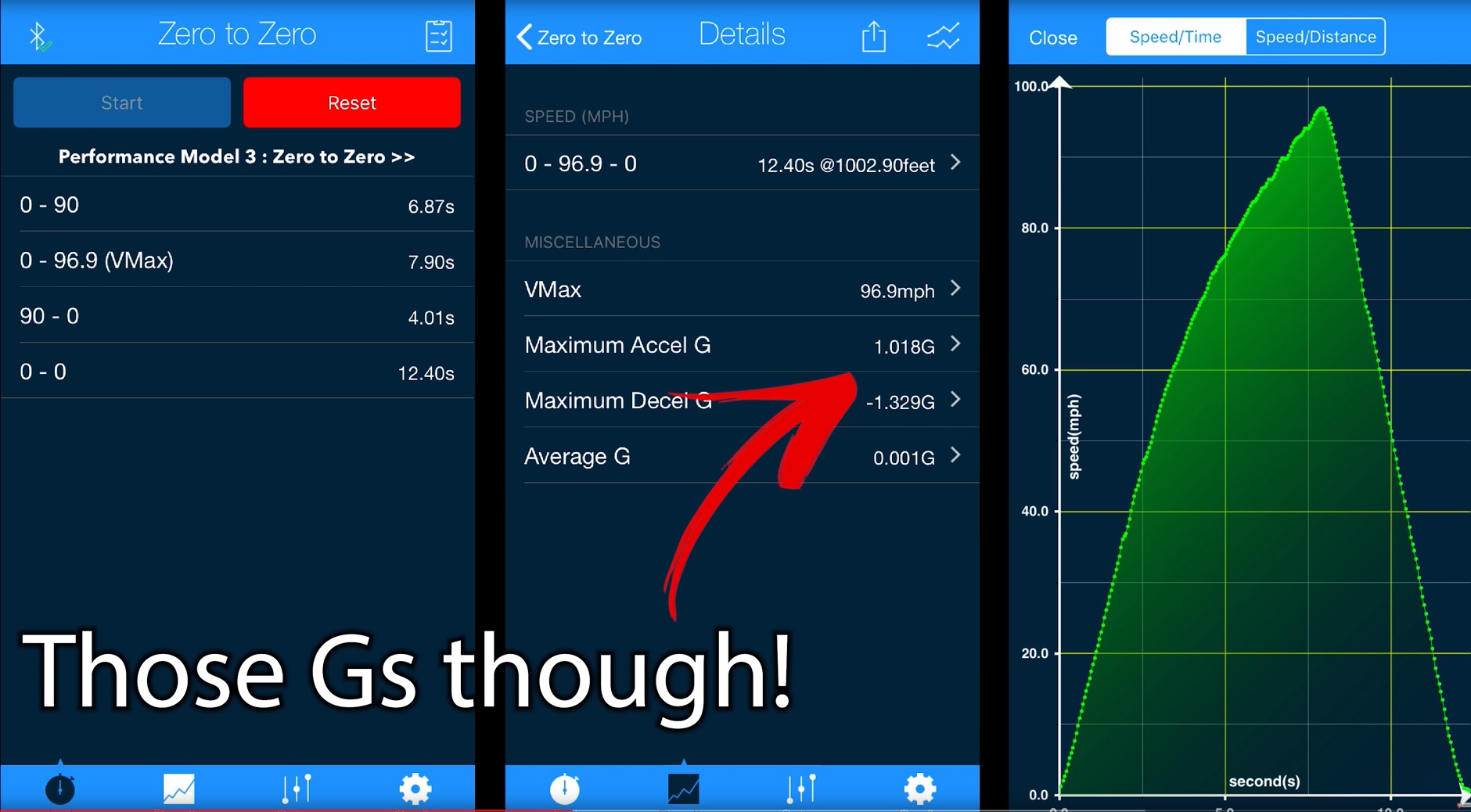

Lifestyle
Tesla Model 3 Performance tries out Porsche’s 0-90-0 mph aircraft carrier challenge
A few days before the Porsche Taycan official unveiling event, the German auto maker debuted a video demonstrating some impressive speed capabilities of the new all-electric sports car on a very special “track” for the occasion. The American aircraft carrier USS Hornet played host to a 0-90-0 mph acceleration and braking test, which clocked 10.7 seconds for the total Taycan run (although the video description says 10.17 seconds). As to be expected from the Tesla owner community, this feat was then challenged in a similar run using a Model 3 Performance, albeit with less impressive scenery.
The Model 3 Performance test run was undertaken and published by Tesla owner and enthusiast Erik from YouTube channel DÆrik, and the results were impressive despite coming in a bit slower than the Taycan test. For the 0-90 mph portion, the Model 3 clocked in at 6.87 seconds; however, braking didn’t begin until the car reached 96.9 mph at 7.90 seconds. From 90 mph to 0 mph, 4.01 seconds elapsed. The total run took 12.4 seconds, although the numbers aren’t ideal given the delay in braking. Removing the extra time from 90-96.9 mph, while acknowledging it’s an imperfect method for time testing, brings the Tesla’s total time for the 0-90-0 run to 10.88 seconds. A few more runs would have been useful for comparison’s sake, but these results alone – a $56,000 midsize sedan vs. a $150,000 sports car – bode very well for the Model 3 overall.

Aside from the lack of an aircraft carrier (and perhaps its surface), there was at least one notable difference between the two tests. Specifically, the Model 3 was a production version of the vehicle with minimal modifications such as ceramic brakes. The Taycan used on the USS Hornet was a prototype of the vehicle, and thus it’s unclear what differences were present compared to any of the other three variants of Porsche’s new electric sports car.
The Porsche Taycan was only recently unveiled, but comparisons between the brand’s entrance into the world of all-electric vehicles (EVs) and the existing Tesla production vehicles are already plentiful and ubiquitous. Thanks to Tesla’s dominance in battery range and impressive performance stats for every model offered, the Taycan’s hefty price tag seems to be one of the biggest factors driving negative reviews. After all, every Model 3 variant is in a much more affordable price range than any of the Taycan variants. As the positive reviews indicate, though, Porsche’s goals for their vehicles have always and will always be miles away from Tesla’s mission. Tesla aims to make electric cars accessible worldwide to nearly every type of consumer while Porsche is, well, Porsche.
Not one to back down from a challenge, CEO Elon Musk has recently indicated that Tesla will be taking on the Taycan soon in a more official capacity. A newly released video of the Taycan’s run at the Nürburgring track in Western Germany showed the performance EV achieving a record-setting 7 minutes, 42 seconds lap time, and now the Model S will challenge those numbers. “Model S on Nürburgring next week,” Musk teased on Twitter. A 2014 test by an independent Model S driver on the same track was hindered by power limitations and overheating; Tesla has since updated the power management software. Perhaps the record will be straightened out next week with both Musk’s and Tesla’s stamp of approval of the results.
Watch Erik Strait’s full 0-90-0 mph run in his Model 3 Performance below:
https://www.youtube.com/watch?v=WihvaYCMXxY

Lifestyle
Tesla Model S Plaid battles China’s 1500 hp monster Nurburgring monster, with surprising results
There is just something about Tesla’s tuning and refinement that makes raw specs seem not as game-changing.

The Tesla Model S Plaid has been around for some time. Today, it is no longer the world’s quickest four-door electric sedan, nor is it the most powerful. As per a recent video from motoring YouTube channel Carwow, however, it seems like the Model S Plaid is still more than a match for some of its newer and more powerful rivals.
The monster from China
The Xiaomi SU7 Ultra is nothing short of a monster. Just like the Model S Plaid, it features three motors. It also has 1,548 hp and 1,770 Nm of torque. It’s All Wheel Drive and weighs a hefty 2,360 kg. The vehicle, which costs just about the equivalent of £55,000, has been recorded setting an insane 7:04.957 at the Nurburgring, surpassing the previous record held by the Porsche Taycan Turbo GT.
For all intents and purposes, the Model S Plaid looked outgunned in Carwow’s test. The Model S Plaid is no slouch with its three motors that produce 1,020 hp and 1,420 Nm of torque. It’s also a bit lighter at 2,190 kg despite its larger size. However, as the Carwow host pointed out, the Model S Plaid holds a 7:25.231 record in the Nurburgring. Compared to the Xiaomi SU7 Ultra’s record, the Model S Plaid’s lap time is notably slower.
Real-world tests
As could be seen in Carwow’s drag races, however, Tesla’s tech wizardry with the Model S Plaid is still hard to beat. The two vehicles competed in nine races, and the older Model S Plaid actually beat its newer, more powerful counterpart from China several times. At one point in the race, the Xiaomi SU7 Ultra hit its power limit due to its battery’s temperature, but the Model S Plaid was still going strong.
The Model S Plaid was first teased five years ago, in September 2020 during Tesla’s Battery Day. Since then, cars like the Lucid Air Sapphire and the Xiaomi SU7 Ultra have been released, surpassing its specs. But just like the Model Y ended up being the better all-rounder compared to the BYD Sealion 7 and the MG IM6, there is just something about Tesla’s tuning and refinement that makes raw specs seem not as game-changing.
Check out Carwow’s Model S Plaid vs Xiaomi SU7 drag race video below.
Lifestyle
500-mile test proves why Tesla Model Y still humiliates rivals in Europe
On paper, the BYD Sealion 7 and MG IM6 promised standout capabilities against the Model Y.

BYD is seeing a lot of momentum in Europe, so much so that mainstream media has taken every opportunity to argue that the Chinese automaker has beaten Tesla in the region. But while BYD sales this year in Europe are rising and Tesla’s registrations remain challenged, the raw capabilities of vehicles like the Model Y are difficult to deny.
This was highlighted in a 500-mile challenge by What Car? magazine, which showed that the new Tesla Model Y is more efficient, cheaper to run, and more reliable than rivals like the BYD Sealion 7, and even the nearly 400 KW-charging MG IM6.
Range and charging promises
On paper, the BYD Sealion 7 and MG IM6 promised standout capabilities against the Model Y. The Sealion 7 had more estimated range and the IM6 promised significantly faster charging. When faced with real-world conditions, however, it was still the Model Y that proved superior.
During the 500-mile test, the BYD nearly failed to reach a charging stop, arriving with less range than its display projected, as noted in a CarUp report. MG fared better, but its charging speeds never reached its promised nearly-400 kW charging speed. Tesla’s Model Y, by comparison, managed energy calculations precisely and arrived at each stop without issue.
Tesla leads in areas that matter
Charging times from 25% to 80% showed that the MG was the fastest at 17 minutes, while Tesla and BYD were close at 28 and 29 minutes, respectively. Overall efficiency and cost told a different story, however. The Model Y consumed 19.4 kWh per 100 km, compared to 22.2 for MG and 23.9 for BYD. Over the full trip, Tesla’s charging costs totaled just £82 thanks to its supercharger network, far below BYD’s £130 and MG’s £119.
What Car? Magazine’s testers concluded that despite BYD’s rapid sales growth and the MG IM6’s seriously impressive charging speeds, Tesla remains the more compelling real-world choice. The Model Y just offers stability, efficiency, and a proven charging infrastructure through its Supercharging network. And as per the magazine’s hosts, the Model Y is even the cheapest car to own among the three that were tested.
Watch What Car? Magazine’s 500-mile test in the video below.
Lifestyle
Tesla Cybertruck slapped with world’s least intimidating ticket, and it’s pure cringe
One cannot help but cringe and feel second-hand embarrassment at the idea of a person just driving around with a stack of these babies.

A Cybertruck parked at Stanford Shopping Center in California was recently hit with what might be the most try-hard piece of paper ever slipped under a wiper blade: a “fake citation” accusing the driver of supporting a “fascist car.”
The note, shared on X by Tesla staff program manager Ryan Torres, quickly made the rounds on X, where it quickly gained attention as an example of how not to protest.
The world’s least intimidating ticket
According to the citation, the supposed “violation” was “driving a fascist car.” The remedial action? Take the bus, call an Uber, or ride a bike. The note also dubbed Elon Musk a “chainsaw-wielding Nazi billionaire.” Now, protests against Tesla and Elon Musk have become commonplace this year, but one cannot help but cringe and feel second-hand embarrassment at the idea of a person just driving around with a stack of fake anti-Tesla/Musk citations.
Torres pointed out the irony himself in his post on X. Tesla currently employs over 140,000 Americans, and SpaceX has put the U.S. firmly back at the top of space technology. As Torres put it, maybe the person behind the world’s least intimidating ticket should “read a book on innovation before vandalizing” other people’s property.
Peak performative clownery
Not to mention that the fake ticket’s logic collapses under its own weight. EVs like the Cybertruck are literally designed to reduce emissions, not “destroy the economy.” If anything, Tesla has bolstered the United States’ economy by fueling jobs in engineering, manufacturing, and clean energy. It’s not the first time a Tesla has been the target of vandalism or politically charged notes, but this one stands out for sheer cringe value.
Torres summed it up neatly: “Peak clownery.” On that point, at least, the citation earns full marks. In a way, though, perhaps cringe fake tickets are not as bad as the literal firebombs that were being thrown at Tesla stores and cars earlier this year because some critics were gleefully misinformed about Elon Musk.








